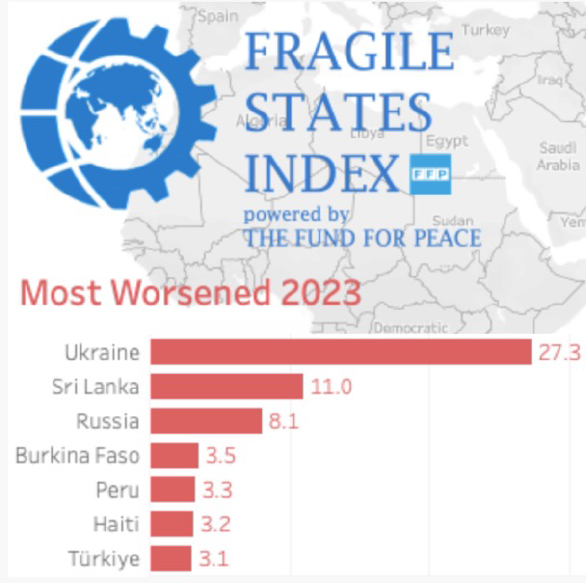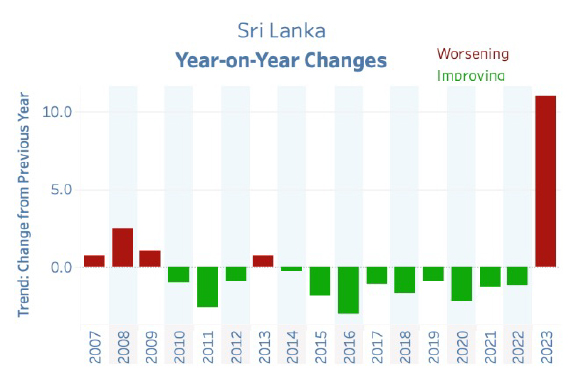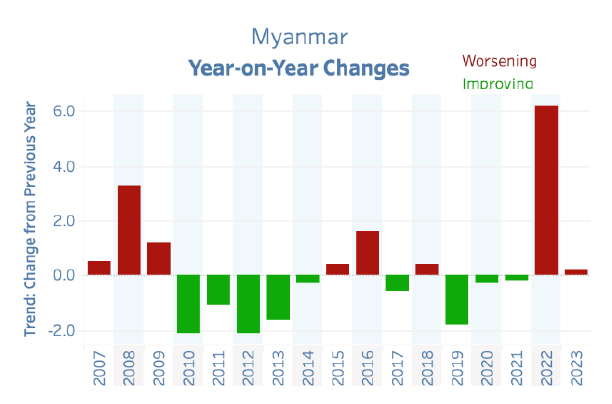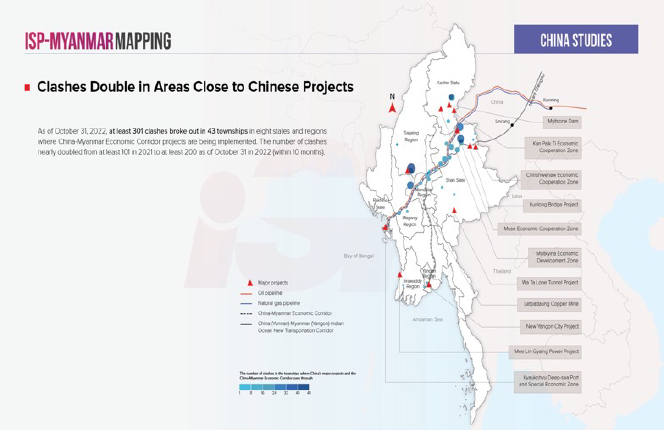
NESA Center Alumni Publication
Asanga Abeyagoonasekera– Executive Director of the South Asia Foresight Network (SAFN) under the Millennium Project in Washington, D.C. He is the author of the recent book ‘Teardrop Diplomacy (2023)’ published by Bloomsbury, and a NESA Alumni.
7 December 2023
“Large Chinese investments in white elephant projects – Kyaukphyu in Myanmar’s Rakhine state and Hambanthota in Sri Lanka also begin to make more sense.” Vijay Gokhale, Former Indian Foreign Secretary[i].
Does fragility matter in geopolitics? Does China exploit fragility in vulnerable nations to gain an edge over its competitors? When a nation is bankrupt, it’s left with few options. Fragility opens a window for external geopolitical intervention impacting domestic and regional security. The great-power competition between the established power, the US, and the rising power, China, has heightened with competing strategic interests in many geographies. Sri Lanka, the South Asian nation, and Myanmar, in Southeast Asia, located at strategic sea lanes in the Indian Ocean, have become victims of geopolitical battles amidst the nation’s fragility. The analysis captures fragility in India’s immediate periphery and China’s geopolitical aspirations amidst the fragile environment in Sri Lanka and Myanmar, impacting regional security.
Fragility in South Asia
South Asia has a unique tendency towards fragility due to political instability, economic crisis, conflicts and heightened geopolitical competition. China has played a leading role in expanding its influence in many fragile countries through coercive economic practices. According to Nate Haken, the Vice President of Research and Innovation at Fund for Peace, which develops the annual Fragile State Index (FSI), “We must not forget to look at the world through the lens of fragility, both in international affairs and at home. Fragility matters, including elements of fragility within the Great Powers themselves.”[ii] While fragility within the great powers is a concern, their external interference towards fragile nations is a much larger issue.
The Fragile State Index (FSI) developed by the Fund for Peace (FFP) presents a warning in its 2023 index. The FSI assessment framework is known as “CAST”[iii] with twelve conflict risk indicators divided over four pillars, which are Cohesion, Economic, Political and Social, that measure the condition of a state at any given moment. The FSI framework makes potential political risk assessment and early warning of conflict, flagging the policymakers and the public. According to the FSI report, three nations in India’s immediate neighborhood are on “Alert” flagging high fragility: Sri Lanka, Myanmar, and Afghanistan (Table 1). Three other nations, Pakistan, Bangladesh, and Nepal, are in the “High Warning” category. The high scores in all six nations indicate the fragility of India’s immediate neighbourhood, which is vulnerable to increased political-economic risk and a conflict-prone environment which would impact the entire region in 2024. Almost all South Asian nations will face elections starting January 2024, adding an apparent political risk factor towards domestic stability. All six nations listed in (Table 1) also have considerable geopolitical contests, where China’s Belt and Road Initiative (BRI) has navigated to their geographies, raising concerns of unsustainable Chinese loans, some seen as white elephant projects adding an extra burden to the fragility faced by these nations. The ‘External Intervention’ score in Sri Lanka has gradually increased from 2022 to 2023, and ‘State Legitimacy’ dropped compared with 2022. Pakistan and Sri Lanka, with a high debt percentage to China, scored 8.3 and 7.9 in External Intervention, the highest among the six countries.
| Country | 2023 FSI Scores | 2023 FSI Warning | FSI External Intervention 2023 |
BRI Investment Value[iv] | Public and Hidden Debt Exposure to China[v] |
| Afghanistan | 100.6 | High Alert | 7.7 | 210m | 1-5% |
| Myanmar | 100.2 | High Alert | 7.3 | 3.33b | >5% |
| Sri Lanka | 90.3 | Alert | 7.9 | 10b | >10% |
| Bangladesh | 85.2 | High Warning | 4.6 | 22.94b | >7% |
| Nepal | 80.2 | High Warning | 5.9 | 2.57b | 1-5% |
| Pakistan | 89.9 | High Warning | 8.3 | 49.38b | >20% |
Table 1: FSI Scores 2023 in six nations[vi] BRI investment and Debt to China.
Figure 1: Credit FSI 2023, The Fund for Peace.
Sri Lanka declared bankruptcy[vii] in 2022 due to the deteriorated economic and political environment, with democratic backsliding being clear indicators, again proving one of the most worsened states in 2023 (see Figure 1). The report states, “Sri Lanka, which is the most worsened country this year after Ukraine, is 4,000 miles away from the European theatre of war but was nevertheless adversely impacted with an exacerbation of an already brewing economic crisis that led to a default on loans including those due to China (BRI)…”. The full-blown political and economic crisis impacted the entire nation, resulting in a high cost of living and rising poverty rates with large-scale migration. Sri Lanka’s immediate neighbour India was the first to assist with a USD4 billion financial package[viii], followed by an IMF bailout[ix]. The IMF diagnostic report[x], which this author contributed as a technical assistant. IMF diagnosed systemic corruption and governance failure as the critical criteria for economic collapse.
BRI in Sri Lanka with non-profitable ventures without much investment flowing in, such as the port city Colombo, was a concern to the Sri Lankan protestors in 2022 that ousted the autocratic rule of Rajapaksa. The public feels the brunt of economic woes from high corruption and governance failure. China was considerably part and parcel of the dysfunctionality, a proven factor in which the present leadership is whitewashing the BRI as a legitimate venture to back and extend support. China is exploiting the fragility of this nation, experiencing economic woes tied to Beijing over large-scale debt and debt restructuring required to stabilize the nation. Further, China is expanding its geopolitical ambitions, leaving fragile nations such as Sri Lanka no other options.
Another fragile nation is Myanmar, which stands out in the 2023 report. With a 100.2 score, Myanmar demonstrates a greater fragility than Sri Lanka, where the recent escalation of conflict between rebels and government forces is heading towards further instability. The fighting from October 2023 had left 283 civilians dead, 334 injured, and 500,000 displaced significantly in Shan state[xi]. Myanmar follows a similar trend in State Legitimacy at 9.3, indicating a drop. Myanmar is also facing geopolitical competition where China has invested in its BRI energy corridor, the China-Myanmar Economic Corridor (CMEC), facilitated by railways, highways, and a deep-water port. The year-on-year point change (Worsening by .20) was less in Myanmar than in Sri Lanka (11.0). (See Figure 2).
Figure 2: Sri Lanka and Myanmar Year-on-Year Changes. Credit FSI 2023, The Fund for Peace[xii].
BRI Connecting Sri Lanka with Myanmar
Special envoy of Chinese President Xi, State Councilor Shen Yiqin, said, “China is prioritizing the extension of the Corridor, the China-Myanmar Economic Corridor (CMEC) to the island nation”[xiii]. During my many interactions with Chinese officials and scholars in the past, I noticed China usually dislikes the word geopolitics. Thus, the BRI ‘Scale up’ proposed by Shen Yiqin further extends a corridor across the ocean towards an island, which is geopolitics at another height. It connects the geo-sphere (land corridor) and marine sphere (Indian Ocean), a conduit created through Sri Lanka facilitating China’s energy pipeline built in Myanmar.
State councillor Shen Yiqin proposed the new geographical extension to Sri Lanka’s President Ranil Wickremasinghe in Colombo on November 20th, 2023. The Sri Lankan president noted that Sri Lanka, a participant in the BRI, “is prepared to embark on the second phase of the initiative, which is expected to make a more substantial economic contribution”[xiv]. The commitment from the Sri Lankan leader was one month after he met with President Xi in the Beijing Belt and Road Forum, where Sri Lanka assured its commitment towards the Belt and Road Initiative. The Chinese foreign ministry’s official news report reads, ‘The two sides should make every effort to push forward the Colombo Port City and Hambantota comprehensive development project, making them flagship projects of China-Sri Lanka Belt and Road cooperation’[xv].
Energy Knots in the BRI
There are two critical knots between China and South-East Asia. Pakistan and Myanmar. The energy corridor from Kashgar in western China south through Pakistan to Gwadar terminates in the Arabic Sea. The other energy corridor is from Kunming in Yunnan Province through Myanmar to Kyaukphyu terminating in the Bay of Bengal. The two energy corridors, the China-Pakistan Economic Corridor (CPEC) and China-Myanmar Economic Corridor (CMEC), sit between Sri Lanka’s maritime route, a reason for China’s perpetual interest in the island nation. The two knots will add China to a secured energy lifeline connecting the greater Middle East hydrocarbon transportation. The oil and gas pipelines are already connecting Kyaukphyu deep water port to Yunnan Province of China, which contributes ‘6 percent of Chinese domestic crude oil consumption, and Myanmar obtains $1 per ton of oil passed through the pipelines’[xvi]. The promising corridor development venture has obstacles due to continuous conflict in Myanmar (See Map 1). Despite the concerns, China has doubled its efforts on CMEC, even with the present Myanmar regime. Lucas Myers at Wilson Center argues, ‘China cannot easily allow CMEC to completely stall in the manner of some other BRI projects, as CMEC’s strategic significance is simply too important.’[xvii]
Map1: Credit: The Institute for Strategy and Policy – Myanmar (ISP – Myanmar).
China-Myanmar Economic Corridor (CMEC) is one of the six BRI land corridors[xviii]. A strategic deep-water port at Kyaukphyu in Myanmar connecting to Yunnan province in China is an extensive large-scale energy project. CMEC bears the most resemblance to the Western Indian Ocean BRI project the ‘China-Pakistan Economic Corridor (CPEC)’. While 33 multiple MOUs were signed with the Myanmar government and China on BRI, several projects such as Muse-Mandalay Railway[xix], a USD 9 billion strategic railway link from Kunming to Kyaukphyu, in addition to a separate road running through northern Myanmar, India’s northeastern states and Bangladesh under the ‘Bangladesh-China-India-Myanmar Economic Corridor (BCIM-EC)’ are part of the BRI expansion.
Beijing’s strategic directive to push Sri Lanka towards the China-Myanmar Economic Corridor (CMEC) has several strategic objectives. First, the Chinese built and leased out the Hambanthota project to link with Myanmar’s Kyaukphyu deep water port. China would benefit from its energy shipments arriving from the gulf through Hambanthota reaching Kyaukphyu port, which has an alternative land route to China’s Kunming province, bypassing the Malacca straits, a possible bottleneck in the geopolitical contest in the future. Second, the Hambanthota Special Economic Zone and Colombo Port City Special Economic Zone will access the ASEAN market through the Kyaukphyu Special Economic Zone, where Chinese goods could be imported and re-exported to several other markets. China, one of the largest trading nations in Sri Lanka with a larger volume of Chinese imports, will benefit. Sri Lanka needs to carefully consider ‘asymmetries between the two economies’[xx] when dealing with the agreed-upon FTA between China and Sri Lanka[xxi], which was another discussion point during Shen Yiqin-Wickremasinghe’s meeting.
According to former Indian Foreign Secretary Vijay Gokhale[xxii], who rightly assesses the security concern from the proposed Kra canal in Thailand, he also sees there is a ‘possibility of both Hambanthota and Kyaukphyu becoming dual-use ports in no longer far-fetched. If this is an idea whose time has come, multiple front preparation by India is needed to meet the challenge.’ Further, Gokhale suggests that ‘India must monitor Chinese plans for Hambanthota and Kyaukphyu to ensure India’s commercial interests aren’t compromised, or Chinese-run ports in the Bay of Bengal don’t gain a monopoly over trans-shipments’. The multi-front preparation Gokhale suggests should be a top priority; unfortunately, it is too late since China has already exploited the fragility in nations like Sri Lanka, agreeing to commit to its expansive geopolitical ambition in the Indian Ocean. The recent Shen Yiqin and Wickremasinghe commitment is a clear example of this. Once the infrastructure is in place with a domestic political push towards China, the Bay of Bengal monopoly over trans-shipments will be a natural flow in the free market space; worse is the security concern when Cambodia Ream port[xxiii] functions as a PLA military base.
Sri Lanka’s strategic circle should consider a broader view of the region before connecting to BRI corridors such as CMEC, which will impact regional security balance, a concern already raised by India. The multiple research ship visits[xxiv] by China to Sri Lanka are already a challenge for India’s national security, and linking ports and corridors will have worse security consequences in the coming days. The political-economic fragility of many developing nations, such as Sri Lanka and Myanmar, are targets for Chinese strategic expansion in the present geopolitical environment.
End Notes
[i] Gokhale V, Dec 2nd, 2023, Times of India, https://timesofindia.indiatimes.com/blogs/toi-edit-page/kra-new-delhis-new-kra-why-a-little-known-isthmus-in-thailand-tells-us-much-about-chinas-indo-pacific-strategy-and-why-it-impacts-andamans-strategically-key-for-india/
[ii] The Fund for Peace, FSI 2023 Index, 2023, https://fragilestatesindex.org/wp-content/uploads/2023/06/FSI-2023-Report_final.pdf
[iii] The Fund for Peace, ‘CAST’ Methodology, https://fragilestatesindex.org/indicators/
[iv] Abeyagoonasekera A, 2023, ‘Teardrop Diplomacy’, ‘Chinese debt to South Asia’, Page 49, Bloomsbury, https://www.politics-prose.com/book/9789356401174
[v] Ibid.
[vi] The Fund for Peace, FSI 2023, https://fragilestatesindex.org/wp-content/uploads/2023/06/FSI-2023-Report_final.pdf
[vii] Mallawarachi B, June 2023, AP News, https://apnews.com/article/sri-lanka-economic-crisis-imf-covid-2de2e38ce099fc6163cb21e28aabf2a9
[viii] ANI, Business Standard, Sep 5th, 2022, India provided nearly $4 billion in food, financial assistance to Sri Lanka,
[ix] Aljazeera, March 20th, 2023, IMF approves Sri Lanka’s $2.9bn bailout,
https://www.aljazeera.com/news/2023/3/20/imf-approves-sri-lankas-2-9bn-bailout
[x] IMF, Sep 29th, 2023, https://www.imf.org/en/Publications/CR/Issues/2023/09/29/Sri-Lanka-Technical-Assistance-Report-Governance-Diagnostic-Assessment-539804
[xi] Nikkei, Dec 6th, 2023, https://asia.nikkei.com/Spotlight/Myanmar-Crisis/Myanmar-s-escalating-conflict-displaces-500-000-more-people
[xii] The Fund for Peace, FSI 2023 Report, https://fragilestatesindex.org/indicators/
[xiii] Srinivasan M, Nov 20th, 2023, China keen on extending China-Myanmar Economic Corridor to Sri Lanka, The Hindu, https://www.thehindu.com/news/international/china-keen-on-extending-china-myanmar-economic-corridor-to-sri-lanka/article67555137.ece
[xiv] Ibid.
[xv] MFA PRC, Oct 20, 2023, https://www.mfa.gov.cn/mfa_eng/zxxx_662805/202310/t20231021_11165313.html
[xvi] Thant Aung Paing, Analysis of CMEC on the Development of Myanmar, Cornell Policy Review, https://www.cornellpolicyreview.com/analysis-of-cmec-on-the-development-of-myanmar/?pdf=6468
[xvii] Lucas Myers, July 20th, 2021, Internal Politics, Instability, and China’s Frustrated Efforts to Escape the “Malacca Dilemma”, Wilson Center, https://www.wilsoncenter.org/blog-post/internal-politics-instability-and-chinas-frustrated-efforts-escape-malacca-dilemma
[xviii] PRC State Councill Info Office, 2020, http://english.scio.gov.cn/beltandroad/2020-08/04/content_76345602.htm
[xix] BRI Monitor, Muse-Mandalay Railway Project, https://www.brimonitor.org/case-studies/muse-mandalay-railway-project/#1614655868545-c561da9a-c081
[xx] IPS, Study on China-Sri Lanka Free Trade Agreement,
https://www.ips.lk/images/docs/research/highlights/Executive Summary.pdf
[xxi] Srinivasan M, Nov 20th, 2023, China keen on extending China-Myanmar Economic Corridor to Sri Lanka, The Hindu, https://www.thehindu.com/news/international/china-keen-on-extending-china-myanmar-economic-corridor-to-sri-lanka/article67555137.ece
[xxii] Gokhale V, Dec 2nd, 2023, Times of India, https://timesofindia.indiatimes.com/blogs/toi-edit-page/kra-new-delhis-new-kra-why-a-little-known-isthmus-in-thailand-tells-us-much-about-chinas-indo-pacific-strategy-and-why-it-impacts-andamans-strategically-key-for-india/
[xxiii] Nakashima E, Cadell C, Jan 6th, 2022, China Secretly building Naval Facility in Cambodia, Washington Post, https://www.washingtonpost.com/national-security/2022/06/06/cambodia-china-navy-base-ream/
[xxiv] Mallawarachi B, Oct 23, 2023, APNews, https://apnews.com/article/sri-lanka-india-china-port-3c9ccfed14a3ec2425b1a8ca610cee80
The views presented in this article are those of the speaker or author and do not necessarily represent the views of DoD or its components.



